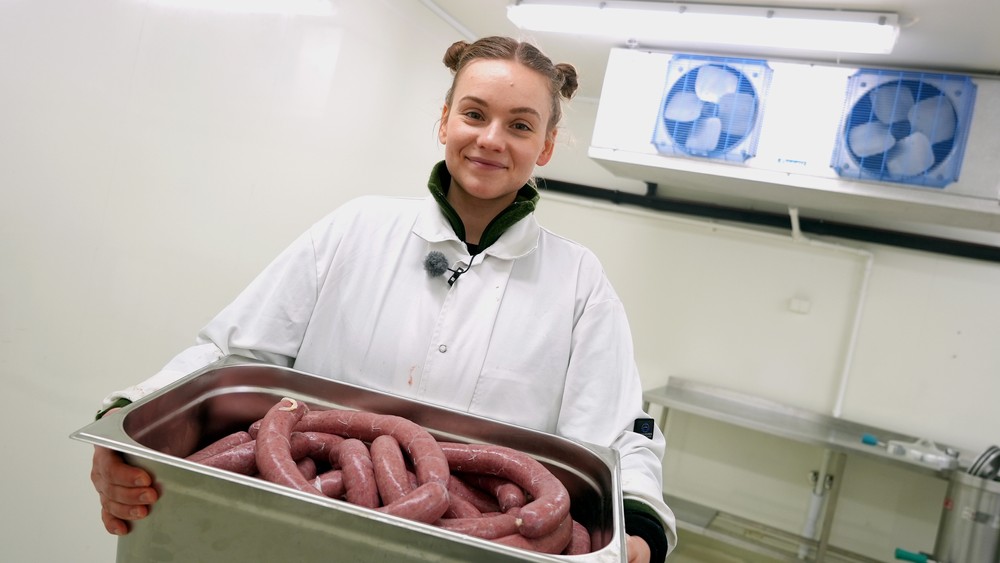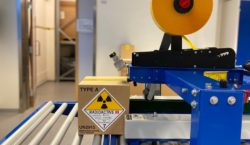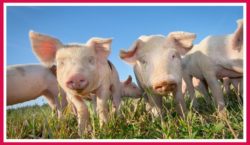
Norwegians love sausages. So much in fact that each Norwegian consumes an average of about 100 sausages a year, which is amongst the highest in the world. But local sausage producers cannot use Norwegian natural casings in the sausages they make and only a few people know that Norway exports its own animal intestines, and then buys sausage casing from China and Europe.
Norwegian chef and entrepreneur, 28 years old Astrid Regine Nässlander was very surprised to discover that it’s impossible to find local Norwegian sausage casing in Norway. The reason is, according to the Norwegian Food Safety Authority, that all intestines from domestic Norwegian animals are exported frozen out of the country as “raw” goods.
Locally produced food has in recent years become increasingly popular and Astrid Regine Nässlander works to ensure that the food we eat is produced and distributed as locally as possible, in a responsible and sustainable way with focus on animal welfare. She made the discovery before Christmas when she started the production of her own Christmas sausages made from local moose meat, but was unable to find local natural Norwegian sausage casing. After some research she was told that all natural casings used to make sausages in Norway are imported from China. Astrid Regine Nässlander says it is completely incomprehensible and continues,
“I do not understand why. I almost do not know if I want to know”.
Nortura is Norway’s largest meat producer and accounts for 65 percent of Norwegian sausage production. Wenche Nordli from the company Norila, which is a subsidiary company of Nortuna confirms that all natural casings used in Norwegian sausage production are imported from abroad. So far this year, Nortura has imported 400,000 bundles of natural casings. Each bundle consists of 91.4 meters of animal intestine.
Nortura is also one of several Norwegian slaughterhouses that export sheep intestines to China and Europe. There, the intestines are processed into, among other things, Wiener sausage casings and sold to several countries in Europe, including Norway. Imports to Norway do not take place directly from China, but via third countries in Europe. Sausage casing is also imported from New Zealand and Australia. Cattle intestines come mainly from South America, and are used for smoked meat sausages, meter sausages and Christmas sausages.

Bodil Nordjore, Food culture conservationist and cookbook author of the book ‘The Good Sausage Book’ says it’s a great paradox. In her book she discusses the fact that local sausage producers cannot use Norwegian natural casings in the sausages they make. In her own sausage production, she uses beef intestines imported from Portugal and says, “It is unreasonable that we who produce sausages, can not get access to Norwegian natural intestine.”
The explanation is not as complicated as the paradox itself however and it is all about quality and economy explains Morten Eriksen, daily leader of the company Notim, which has supplied natural casing to sausage producers in Norway for the past 20 years.
Intestine production is both an expensive and labor-intensive production and with Norway being such a small market it’s simply not possible for it to be profitable. According to Notim, Norway is also one of the most demanding markets in the world when it comes to the quality of natural casings and the meat stuffing used in sausage production in Norway traditionally has a relatively high water content, so even the slightest defect in the intestines will be visible in the sausage production. At the same time, it is important to note that these are traditional recipes that are well incorporated into Norwegian food traditions, so it is not just about finances, but also about the consumer’s expectations of how a sausage should be and should look.
Morten Eriksen says that much of the processing of natural casings takes place in China, which is where much of the knowledge and experience in the industry lies.
Read the full article from NRK here




Dear Ms Mette Larsen,
May I compliment you on your excellent and informative article, on the Norwegian love of sausages, particularly those made with natural casings.
You state that due to the limited amount and availability of local Norwegian natural casings the majority of product used is imported, mostly from China. This is only partly true and needs further elaboration. While the bulk of these casings may have had their final shipment from China, they are not Chinese origin casings. Natural casings are produced in a large number of countries of the world and traded on the international market. They are produced under strict industry standards and international regulatory inspection and certification, with full traceability. As your article states China has a long experience and expertise in the processing and selection of natural casings, it handles a large volume of the available international natural casings, but they originate from a large number of countries. In fact China is an extended workbench for the worldwide natural casing industry.
Companies handling and processing natural casings are represented by the international organisation – the International Natural Sausage Casings Association (INSCA). Today, INSCA’s membership includes a balance of European, North and South American, Asian. Middle Eastern, to the New Zealand, Australian and African countries. Casings originating from these countries are traded widely on the international market, either as finished product or receiving further processing in another country.
Further details on INSCA and on the international natural casings industry are available at http://www.insca.org .
Michael Hackner
INSCA